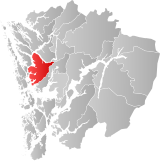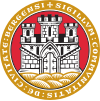lat_seclon_seclon_minlat_deglon_deglat_min
Bergen Municipality
Bergen kommune | |
|---|---|
 {{{map_caption1}}} | |
| Country | Norway |
| County | Hordaland |
| District | Midhordland |
| Administrative centre | Bergen |
| Government | |
| • Governor (2004) | Herman Friele (H) |
| Area | |
| • Total | 465 km2 (180 sq mi) |
| • Land | 445 km2 (172 sq mi) |
| • Rank | #215 in Norway |
| Population (2006) | |
| • Total | 242,158 |
| • Rank | #2 in Norway |
| • Density | 534/km2 (1,380/sq mi) |
| • Change (10 years) | |
| Official language | |
| • Norwegian form | Neutral |
| Time zone | UTC+01:00 (CET) |
| • Summer (DST) | UTC+02:00 (CEST) |
| ISO 3166 code | NO-1201[2] |
| Website | Official website |
Bergen is a municipality and city in the county of Hordaland, Norway.
Bergen is the second largest city in Norway. It is located on the south-western coast of Norway, between a group of mountains known collectively as de syv fjell ("the seven mountains"). Bergen is also known as the gateway to the fjords of Norway.
History
The city of Bergen appeared in the 11th century. According to the sagas it was founded by Olaf Kyrre. In modern times, the year AD 1070 has been decided upon as the year of foundation. It was considered to be Norway's capital in the 13th century until 1299. Toward the end of the thirteenth century, Bergen became one of the Hanseatic League's four most important bureaus. The reason for its importance was the trade in dried cod from the northern Norwegian coast, starting up around 1100. The German hanseatic merchants lived in their own separate quarter of town, where low German was spoken, enjoying exclusive rights to trade with the northern fishermen that each summer sailed to Bergen. Today, one still gets a feel of this at the quayside of Bergen called Bryggen, today on the UNESCO list of World Heritage sites.
In 1349, the Black Death was introduced to Norway by the crew of an English ship arriving Bergen. In 1429 descendants of the Victual Brothers attacked Bergen with some ships, plundered the town and burned it down. In 1536, the king was able to force the German merchants to become Norwegian citizens or return home, heralding a decline in the German influence.
Throughout the 15th and 16th century, Bergen remained the biggest city in the Nordic countries, and it remained Norway's biggest city until 1850, when overtaken by Oslo. Bergen retained its monopoly of trade of Northern Norway until 1789.
In 1916, parts of the city centre were destroyed by a devastating fire. In 1944, during the German occupation, a Dutch cargoship anchored off the Bergenhus fortress, filled with explosives, blew up, killing many people and damaging historic buildings.
In 1972, Bergen was unified with neighbouring municipalities (Arna, Fana, Laksevåg and Åsane), thereby getting its present boundaries.
Cityscape
The oldest part of the city is on the north side of the bay of Vågen. Here you find Bryggen, a number of old, wooden houses dating from the early 18th c., but still giving a medieval feel. The Saint Mary Church is the oldest church of Bergen, dating from around 1130. Two other churches, the Cathedral and the Korskirken church are also medieval, although modified later. The fortress of Bergenhus has a number of interesting buildings, notably the Haakonshallen royal hall from the 13th c., and the Rosenkrantz Tower, built around a medieval fortification in the 16th century.
A popular tourist attraction is the open air fishmarket on the harbour. Further down you find the main shopping area, rebuilt after a fire in 1916 in art nouveau and functionalism, around the main square Torgalmenningen. Several old quarters of white, wooden houses surround the centre, notably Nordnes, Marken and Sandviken. Nygårdshøyden is a quaint area with a large number of brick buildings from about 1900.
Visitors should not miss the ride with the funicular up to Mount Fløyen, where one is rewarded with a splendid view over the city and the fabled seven mountains. The aquarium with seals, penguins and fish from the area is very popular.
Strolling around in Bergen will reveal areas with very differing architecture. Quaint wooden houses are abundant, and patched around central Bergen.
Administration
Since 2000, the city of Bergen is governed by a city government (byråd) based on the principle of parliamentarism. The government consists of 5 government members called commissioners, and is appointed by the city council, which is the supreme authority of the city. Since 2003 the city has been ruled by a centre-right coalition of Høyre (conservatives), the Christian Democrats and Venstre (liberals).
Weather
- See also: Geography of Norway
Bergen is renowned for its plentiful rainfall which makes up most of the 2250 mm (88 in) yearly average precipitation. For some years there were paraplyautomater (umbrella vending machines) installed in the streets, however, they did not turn out to be a success. Bergen is one of the warmest cities in Norway, thanks to the Gulf Stream. The warmest temperature ever recorded is 31.8°C in 1947, the coldest ever recorded is -16.3°C in 1987.
Universities and research
The University of Bergen (UiB) [1] is known for its strong marine biology and geology (petroleum) research. Recently the university was awarded three national centers of excellence [2] in climate research [3], petroleum research [4] and medieval studies [5]. In December 2004, billionaire Trond Mohn donated 250 million NOK to the University as research funding. Only months later (April 2005), he added an additional NOK 50 million. UiB has approximately 17,000 students and 2,500 staff.
Bergen University College [6] offers studies of high quality directed towards specific professions. The college is organised in 3 faculties: Faculty of Education, Faculty of Engineering, and Faculty of Health and Social Sciences. HiB has approximately 6,000 students and 600 staff.
Bergen is also home of the Norwegian School of Economics and Business Administration (NHH) [7], a leading school of business and economics in Norway. Finn E. Kydland, the last (2004) of three Norwegian laureates of the "Nobel Prize" in economy, has studied and lectured at this school. NHH has approximately 2,800 students and 300 staff.
Industry
Main businesses in Bergen are:
- a large oil industry
- banking services
- TV industry (TV 2 - the largest commercial TV station's headquarters)
- deep sea operations
- fishing operations
- large vessel harbour
- university (approx. 17 000 students)
- Bergen University College (6000 students)
- hotel services
- largest cruise vessel harbour in northern Europe
Communication
Bergen has an international airport, Bergen Airport, Flesland, with direct flights to many European cities. The Bergensbanen railway line runs east to Voss, Geilo, Hønefoss and Oslo. Public transportation is provided by Gaia Trafikk and Hardanger Sunnhordlandske Dampskipsselskap (HSD). Local train transport to Arna is provided by Norges Statsbaner. There is also a funicular (Fløibanen) and an aerial tramway (Ulriksbanen). The tramsystem was closed in 1964, although a museum-line still operates on Møhlenpris. A modern tramway line connecting the city-centre with Nesttun and Bergen Airport is in the works and has been passed by Stortinget. Among the fleet of about 450 buses are 8 trolleybuses (two of them are dual-mode buses), making Bergen the only city in north-west Europe to have them.
Eastbound, highway E16 run to Voss, Valdres and Oslo. Along the coast, highway E39 run south to Haugesund, Stavanger and Kristiansand, and north to Førde, Ålesund, Molde and Trondheim. Express buses ply both highways, as well as serving numerous other destinations.
The Norwegian coastal steamer Hurtigruten originates in Bergen, running north to Trondheim, Bodø, Tromsø and Kirkenes. Passenger catamarans run from Bergen south to Haugesund and Stavanger, and north to Sognefjorden and Nordfjord. Car ferries connect to Hanstholm and Hirtshals in Denmark, Newcastle in the United Kingdom, Tórshavn on the Faroe Islands, and Reykjavík on Iceland.
Culture and sports
Bergen is also an important cultural centre in its region and in Norway, maybe best known for hosting the annual Bergen International Festival (Festspillene i Bergen) [8]. The city is home of the Bergen Philharmonic Orchestra, which was founded in 1765 and is one of the world's oldest orchestral institutions. The orchestra performs regularly at the 1,500 seat Grieg Hall [9]. Bergen was a European Capital of Culture in 2000. Other main cultural events includes Nattjazz and Bergenfest (formerly Ole Blues).
In addition, there are numerous amateur bands in Bergen and the surrounding communities, performing regularly throughout the city. They generally fall within two distinct categories: brass bands, following the British band tradition, and Janitsjar or wind bands, which include both woodwind and brass instruments. Both of these types of bands tend to be quite competitive, and the Grieg Hall in Bergen is home to the annual Norwegian Brass Band Championships, which takes place in late winter.
In the late 1990s and early 2000s many pop and rock artists from Bergen became famous, at home and abroad. Many of these were connected to the small record label Tellé. In domestic press this became known as the Bergen Wave. Musicians and bands from Bergen include Annie, Burzum, Erlend Øye, Kings of Convenience, Röyksopp, and Sondre Lerche.
Bergen has a small but thriving scene for contemporary art, most notably centered around BIT Teatergarasjen, Bergen Kunsthall, United Sardines Factory, USF and Bergen Center for Electronic Arts, BEK.
The biggest football team, S.K. Brann, plays in the Norwegian Premier League (2006), while Løv-Ham Fotball plays in first division. The biggest women's football team is Arna Bjørnar.
Famous people from Bergen
- Trond Torleivsson Benkestok, nobleman (1490–1558)
- Ludvig Holberg, playwright (1684–1754)
- Ole Borneman Bull, violinist, composer (1810–1880)
- Gerhard Armauer Hansen, leprosy researcher (1841–1912)
- Edvard Grieg, composer, pianist (1843–1907)
- Christian Michelsen, ship owner, prime minister (1857–1925)
- Carl Joachim Hambro, politician, President of Parliament (1885-1964)
- Johan Nordahl Brun Grieg, poet, author (1902–1943)
- Roald Jensen, soccer player (1943–1987)
- Terje Rød Larsen, diplomat, sociologist (1947-)
- Jan Eggum, singer, songwriter (1951–)
- Sissel Kyrkjebø, singer (1969–)
- Varg Vikernes, musician, arsonist, murderer (1973–)
- Erlend Øye, musician (1975–)
- Kurt Nilsen, musician (1978–)
- Sondre Lerche, musician (1982–)
Twin cities
Bergen has several sister cities. They are:
See also
External links
- ^ "Forskrift om målvedtak i kommunar og fylkeskommunar" (in Norwegian). Lovdata.no.
- ^ Bolstad, Erik; Thorsnæs, Geir, eds. (2023-01-26). "Kommunenummer". Store norske leksikon (in Norwegian). Kunnskapsforlaget.
